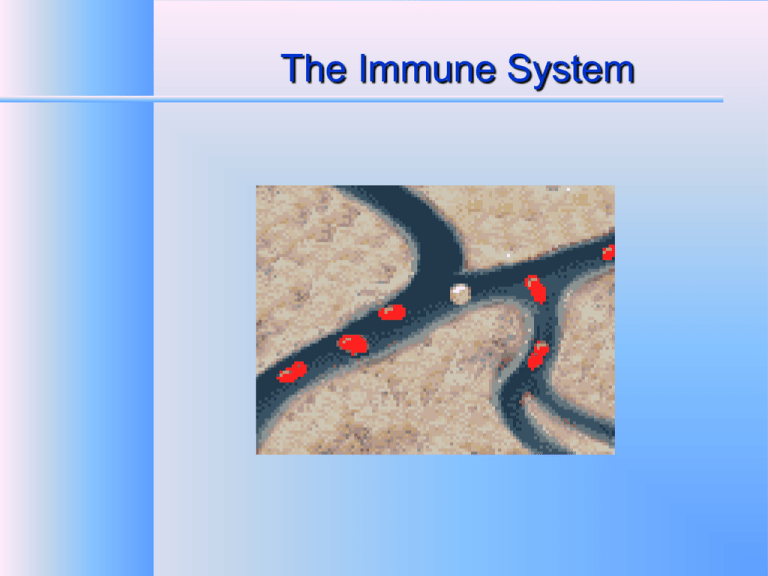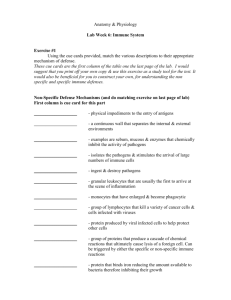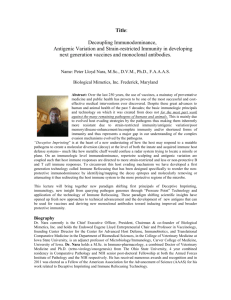Immune system notes
advertisement

The Immune System History of Disease • The history of disease: – 7000 B.C. Ancient civilizations drill holes in people’s head to release what were thought to be evil spirits but were really diseases (Trepanation) – 460-377 B.C. –Hippocrates (a Greek physician) hypothesizes that disease is caused by fluids he called humors – 1330-1352 – Black death (bubonic plagues) strikes the world. • ½ the world’s population dies from it (about 75 million people) • People burn incense in an attempt to cure it History of Disease • The history of disease (continued): – 1400-1600 Humans begin studying anatomy – 1857 – Louis Pasteur hypothesizes that disease is caused by tiny “animals” (that is where we get Pasteurized milk) – 1865 – Joseph Lister – finds that sterilizing surgical tools reduces patients’ infections (this is where we get the name Listerine) History of Disease • The history of disease (continued): – 1883 - Robert Koch makes 4 Postulates that prove pathogens cause disease – 1928 – Alexander Fleming discovers penicillin (the first major antibiotic) – 1955 – Jonas Salk finds Polio vaccine – Late ’80’s - Worldwide spread of HIV (which causes AIDS) especially in 3rd world countries – 2002 SARS pops up in China Basics of Disease • Basics of disease: – Pathogen – an agent that causes disease (pathology – the study of disease) – Epidemic – rapid outbreak of a disease that affects many people – Pandemic – when a disease is common in the population (like the common cold or flu) – Germ theory – specific microorganisms cause diseases – CDC – Center for Disease Control – based in Atlanta, Georgia; is responsible for monitoring diseases and maintaining credible information for them Basics of Disease – Infectious disease – a disease caused by a foreign organism or agent – Contagious disease (also called communicable disease) – a disease that is spread from one living thing to another – Vector – anything that carries a pathogen and transmits it to healthy cells – Patient zero (or index case) – first known person to contract a certain disease – Outbreak – a small localized group of people or organisms that are infected with a particular disease Types of Pathogens • Types of pathogens: – – – – – – Bacteria Viruses Fungi Protozoans Parasites Prions The Immune System • Types of pathogens: – Bacteria – small single celled organisms that make many copies of themselves in a short amount of time; they also can release toxins to make people sick; they can be typically treated by medicines called antibiotics – Viruses – nonliving strands of DNA that are surrounded by protein coats; these pathogens are harder to treat than bacteria Types of Pathogens – Fungi – single or multicellular organisms that pierce healthy cells and steal their nutrients; they usually occur in warm damp places; can usually be treated with creams; and example includes athlete’s foot Fuzzy Tongue Types of Pathogens – Protozoans – single celled organisms that prey on other cells; one main example is malaria – Parasites – organisms that grow and feed on a host; an example of a parasite is elephantiasis caused by filaria which is a microscopic worm Types of Pathogens – Prions – small nonliving chains of amino acids (usually 3-4); responsible for mad cow disease Quiz 1-6: List the 6 types of pathogens: 1. 2. 3. 4. 5. 6. 7-8: Most pathogens are either 7. ____ or 8.____ . 9. What is the term that describes a chemical that can kill most bacterial infections? 10.Who discovered the first form of this type of chemical? Quiz 1. Bacteria 2. Viruses 3. Protozoans 4. Fungi 5. Parasites 6. Prions 7. Viruses 8. Bacteria 9. Antibiotic 10.Alexander Fleming The Immune System • Routes of transmission – different ways that pathogens can get into the body. • Routes of transmission include: – – – – – – Body fluids (blood, saliva, semen, etc.) Bites Mosquitoes Open wounds Direct touch Eating or drinking something The Immune System – Aerosol (that is they are airborne) – Needles (unsterilized or among drug users) – Sexual intercourse Functions of the Immune System The immune system functions in: • Non-specific immunity – trying to protect the body from all invaders • Inflammatory response – making sure that in a non-specific immune situation more blood flow is sent to the infected or damaged area • Specific immunity – the immune system targets specific pathogens or toxins Nonspecific immunity Nonspecific immunity: • Includes the skin and the mucous membranes • Protects against virtually every type of pathogen • Inflammatory response – redness or heat felt in the infected area – This is due to increased blood flow – Increased blood flow means increased white blood cells Nonspecific immunity Nonspecific immunity: • Fevers – the body can stimulate production of immune cells and molecules easier with a higher temperature • The body regulates at a higher temperature (100-102) • Pyrogens – pathogens that can mess with the body’s temperature set point Specific immunity Specific immunity: • Where the immune system will target specific diseases • This is usually in the form of different white blood cells (WBC’s) and other immune system cells that circulate in the blood • Specific immunity is selective Nonspecific immunity Types of Specific immunity: • Passive immunity – immunity to a certain disease is always in the body whether the body is infected or not – Usually can be passed from mother to child through genetics (DNA) or through breastmilk • Active immunity – immunity that the body produces in response to a specific infection Immune System Molecules 0128-08 Antibodies – proteins that have a specific shape to target and destroy specific foreign proteins Antigens – foreign molecules in the body either from or on a pathogen Interferons – proteins released by infected cells to healthy cells to interfere with a pathogen infecting the healthy cells Immune System Cells 01-28-08 White blood cells – cells that travel in the blood and fight against infections that have made it into the body Phagocytes – class of white blood cells that engulfs and destroys pathogens Immune System Cells\ Make a chart like this: Type of WBC Function Drawing Immune System Cells 01-28-08 Types of white blood cells and their functions: 1. Basophils – Makes chemicals that cause inflammation in the blood stream 2. Mast cells – Makes chemicals that cause inflammation in other body tissues Immune System Cells 01-28-08 3. Neutrophil – phagocyte; engulfs proteins and foreign invaders 4. Macrophage – engulfs dead or dying body cells and some bacteria; phagocyte Immune System Cells 5. Lymphocyte – Destroys infected body cells or produces proteins that inactivate pathogens (interferons); there are 2 types of lymphocytes: a. T-lymphocytes – destroy body cells that are infected with pathogens b. B-lymphocytes – produce proteins that inactivate pathogens that have not yet affected a body cell (using interferons) Immune System Cells 6. Eosinophil – Injects poisonous packets into parasites and protozoans Immunity 01-25-08 Memory cells – specialized T and B cells that “remember” an antigen from a pathogen This allows the T & B cells to destroy the pathogen a 2nd time before the body gets sick. Tissue Rejection Tissue rejection – when blood or organs are attacked by the immune system as a “foreign” invader. WBC’s have protein markers called antibodies on their cell’ membrane Tissue Rejection These antibodies have a specific shape. If an antigen on the surface of a pathogen or other foreign tissue fits this antibody, the WBC will recognize it as foreign and attack it Tissue Rejection If you get an organ or blood, you have to take drugs to weaken your immune system. This decreases the chances of tissue rejection. This increases the chances of getting other diseases. Fighting Disease Antiseptics – heat or cheimcals used to kill pathogens outside the body; they are not specific; they may include soap, vinegar, and rubbing alcohol. Antibiotics – medicines in the body that target bacteria and fungi; may include penicillin, amoxicillin, streptomycin, and tetracycline The Diseases Strike Back Antibiotic resistance – when bacteria mutate so that they are no longer affected by anitbiotics Fighting Disease Vaccines – medicines that are actually weakened forms of pathogens to activate your memory cells so that you don’t get sick The memory cells kick in immediately the second time a pathogen is experienced in the body Fighting Disease There are 4 types of vaccines: 1. Whole vaccines – whole dead bacteria or viruses 2. Live attenuated vaccines – weak living pathogens. Fighting Disease 3. Component vaccines – use only part of the pathogen (usually the membrane with the antigen on it) 4. Toxoid vaccines – inactivated bacterial toxins; e.g. botox, tetanus vaccine Immune System Diseases 1. HIV – Attacks the T cells in the immune system; HIV patients usually get sick from all the other disease that can now enter the body. 2. Leukemia – cancer of the white blood cells; they shut down or start fighting the body themselves Autoimmune Diseases Multiple sclerosis – the WBC’s attack the nerve cells; you lose coordination Lupus – the WBC’s attack the body Cycles • Lytic and lysogenic cycle • • Bacteriophage - virus that infects a bacteria • Lytic - "lyse" to burst • Lysogenic - to hide Cycles








